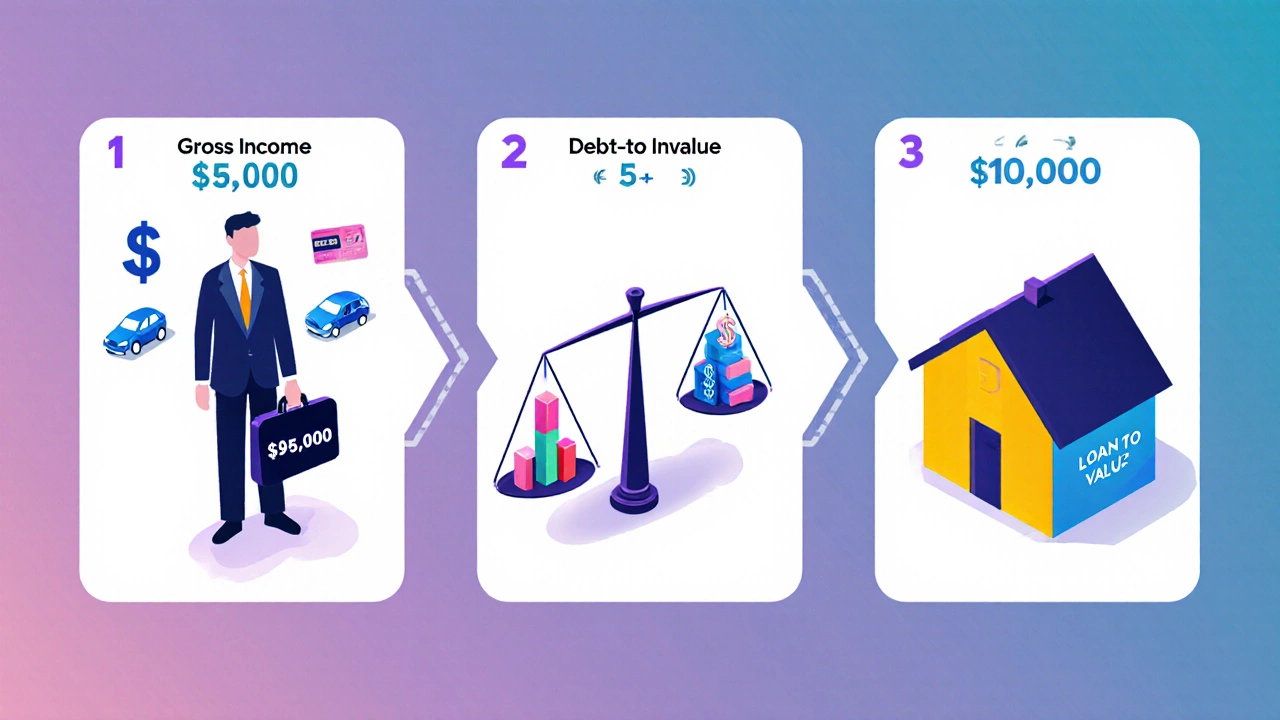Mortgage Borrowing Calculator
Calculate Your Borrowing Power
Estimate your maximum mortgage amount based on income, debt, and deposit. This is an estimate only - actual borrowing power depends on lender policies, credit score, and other factors.
When you start dreaming about a house, the first question usually pops up: mortgage borrowing calculator. You want to know if your salary will stretch far enough to cover a mortgage, and if not, what you can tweak. Below we break down exactly how lenders turn your income into a borrowing limit, walk through a simple calculation, and give you a checklist to maximise what you can borrow.
What Is Borrowing Power?
Mortgage borrowing power is the maximum loan amount a bank or lender is willing to approve based on the borrower’s financial profile. In NewZealand, lenders typically use a multiple of your gross annual income - often between 4.5×and 5.5×- but they also factor in existing debts, the intended loan‑to‑value ratio (LVR), and your credit health.
How Income Shapes Your Loan
Income is the headline number, but lenders dig deeper:
- Gross annual income - the total before tax, bonuses, overtime, or commissions.
- Employment stability - permanent, contract, or self‑employment. Self‑employed applicants usually need to supply two years of tax returns.
- Additional streams - rental income, dividends, or government benefits can be added, but usually at a reduced weighting (often 50%).
In practice, a bank will take your gross income, apply a multiplier, then adjust for the other factors mentioned above.

Key Ratios That Put a Cap on the Loan
Two ratios dominate the calculation:
- Debt‑to‑Income (DTI) ratio - total monthly debt repayments divided by gross monthly income. Most NZ lenders cap DTI at 30‑35%.
- Loan‑to‑Value (LVR) ratio - loan amount divided by the property’s appraised value. Borrowers with less than a 20% deposit face an LVR ceiling of 80% (sometimes 75% for loans over $1million).
Both ratios work together. Even if your income suggests a $800,000 loan, a 20% deposit on a $500,000 home forces an LVR of 80%, limiting the loan to $400,000. The remaining $400,000 would need to come from savings or a co‑borrower.
Step‑by‑Step: Rough Borrowing Calculation
Let’s walk through a quick "back‑of‑the‑envelope" calculation using a common multiplier of 5×gross income. This is only an estimate - the exact figure will depend on your DTI, LVR, and the lender’s risk appetite.
- Identify gross annual income. Example: $95,000.
- Apply the income multiplier. 5×$95,000 = $475,000.
- Check the DTI limit. Add up all monthly debt repayments (car loan $400, credit‑card $200, student loan $300 = $900). Gross monthly income = $95,000 ÷ 12 ≈ $7,917. DTI = $900 ÷ $7,917 ≈ 11% - well under the 30% ceiling.
- Determine LVR based on deposit. If you have a $100,000 deposit, the max property price you can target is deposit ÷ (1-LVR). Assuming an 80% LVR, maximum price = $100,000 ÷ 0.20 = $500,000. The associated loan would be $400,000.
- Take the lower of the two limits. Income‑based limit = $475,000; LVR‑based limit = $400,000. Therefore, you could realistically borrow about $400,000.
This method gives you a ballpark figure before you even talk to a mortgage broker.
Comparison of Typical Multipliers & LVR Caps
| Gross Annual Income | Multiplier Used | Income‑Based Limit | Typical LVR (20% deposit) | Loan Amount You Can Secure |
|---|---|---|---|---|
| $70,000 | 4.5× | $315,000 | 80% | up to $280,000 |
| $95,000 | 5× | $475,000 | 80% | up to $400,000 |
| $130,000 | 5.5× | $715,000 | 80% | up to $600,000 |
Notice how the loan amount you can actually get is often lower than the income‑based limit because the LVR rule pulls the ceiling down.

Common Pitfalls & How to Boost Your Borrowing Capacity
- Carrying high‑interest debt. Credit‑card balances raise your DTI. Paying them down can free up several thousand dollars of borrowing power.
- Missing out on a larger deposit. Saving an extra $10,000 can lift the LVR ceiling from 80% to 85%, unlocking up to $50,000 more loan.
- Poor credit score. In NewZealand, a score below 600 may trigger higher interest rates or stricter DTI limits. Review your credit file, correct errors, and settle overdue accounts.
- Unstable income streams. Freelancers can improve their profile by presenting at least two years of tax returns and a clear contract pipeline.
Working with a mortgage broker can also reveal lender‑specific multipliers - some lenders are willing to stretch to 6×income for high‑net‑worth clients.
Quick Checklist Before You Apply
- Calculate your gross annual income and apply an appropriate multiplier (4.5‑5.5×).
- List all monthly debt repayments; ensure DTI stays under 30%.
- Determine how much deposit you can afford; use the LVR formula to see the max property price.
- Check your credit score and clear any overdue accounts.
- Gather proof of income (payslips, tax returns) and a recent bank statement.
- Consider speaking with at least two lenders or a broker to compare multiplier policies.
Follow this list and you’ll walk into a lender’s office with a clear idea of the loan amount that matches your financial picture.
Frequently Asked Questions
What income multiplier do most NewZealand banks use?
Most major banks sit between 4.5×and 5×gross annual income. Some premium lenders may stretch to 5.5×or higher for borrowers with excellent credit and low debt.
Can a co‑borrower increase my borrowing power?
Yes. Adding a partner’s income combines the two gross salaries, effectively doubling the income‑based limit, while the total debt load - and the DTI - is shared across both borrowers.
Does my student loan affect my mortgage eligibility?
Student loans count as a monthly repayment in the DTI calculation, so a large student debt can shrink the loan you qualify for. Some lenders treat government‑subsidised loans more leniently, but it’s best to include them in your estimate.
What is the minimum deposit needed for a first home in NZ?
The government’s First Home Loan (Kei Tahi) allows a 5% deposit for homes up to $500,000, but most conventional lenders still require at least 10‑20% to stay within their LVR limits.
How often should I re‑run the borrowing calculator?
Whenever your financial situation changes - a raise, a new loan, or a larger deposit - run the numbers again. Even a 5% change in income can shift your borrowing power by $20,000‑$30,000.
